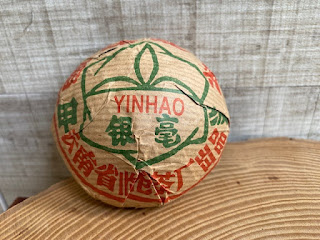I received a feedback on my tea storage.
He is coincidentally a fellow local. He claimed and believed that my tea storage is considered wet storage. Singapore has a climate which is hot and humid throughout a year. As I did not take special steps to reduce the exposure of my tea to this hot and humid climate, my tea is not 'dry stored'. This reader stored his tea this way - plastic cling wrapped his paper wrapped tea, then placed in a zip lock bag and a pack of drying agent is inserted to this bag and the tea is kept away in a cardboard box. This seem to suggest that the reader is 'minimising' his tea to humidity and airflow.
Here are my 2 cents of thoughts:
1. I do not expose my pu erh tea directly to the Singapore climate. I do not bring out my tea to my yard and expose them directly to the weather of Singapore.
2. I keep my tea in their original tongs (whether bamboo or paper) in a pu erh box. I keep all my tea in 2 empty bedrooms just for tea storage. Windows are closed and curtains drawn. I do nothing else. I let time do its work. The rooms are clean and dry. I considered my storage as dry stored but in a climate outside that is hot and humid. My tea had been stored under these conditions for more than 10 years.
3. Traditional Hong Kong tea shops used to store their tea within the shops (pre war shop houses) in the past. They might have a basement where the tea is kept. The storage conditions there would be slightly more humid and a seasoned tea drinker can actually discern the humidity within the tea when the tea is brewed. Today, such tea storage are non existent in Hong Kong and the pu erh tea are now kept in clean dry rooms. I happened to have a few older pu erh tea that was slightly exposed to the old style humidity but was later stored in drier conditions during the later part of the tea storage. I enjoyed such tea and they have a pleasant distinct aroma and taste in the tea.
4. Taiwan tea shops sells old pu erh. Most of these old tea were purchased from Singapore, Malaysia and Hong Kong and were resold in Taiwan. It is not surprising that the older pu er found in Taiwan has taste and aroma characteristics of Malaysia and Hong Kong.
Pu erh tea stored in Malaysia, Hong Kong, Guangzhou, Kunming will have its own storage's taste and aroma. I bring my tea tea every time to these places and have tea with my tea buddies from these countries. Yes, I have loyal tea drinkers that believe their country's storage is best and would regard other countries' storage as less than ideal. However, they would have a different opinion when they do a blind taste taste.
I am not saying a particular country has a better or best storage. Every country storage is unique. Tea drinkers should enjoy and appreciate the various storage conditions of pu erh from different regions. It is an adventure in every cup.

















































